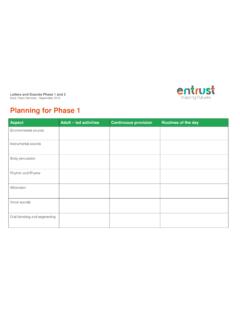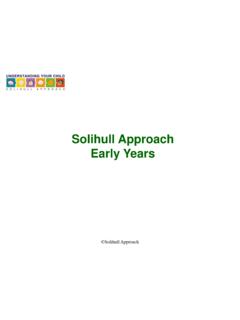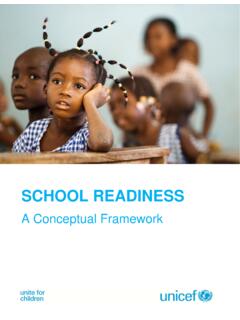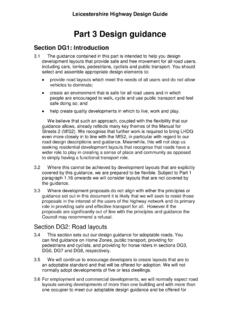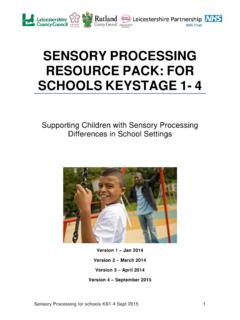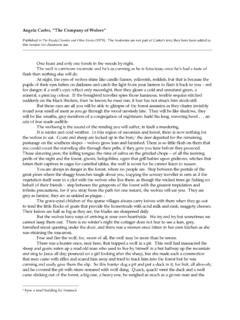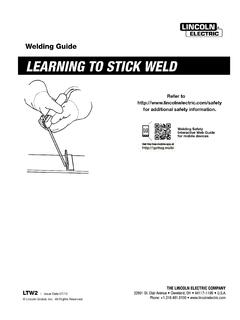Transcription of Early Years Sensory Processing Resource Pack
1 Sensory Processing Resource pack : Early Years Working with Children with Sensory Processing Differences in Early Years Settings For those working within an Early Years setting or Health Visitors who work with families who may have young children showing signs of Sensory Processing differences. This Resource pack will assist with the identification of possible difficulties and support the implementation of strategies. This Resource pack is the result of collaboration between Leicestershire Partnership NHS Trust, Leicestershire County Council, Leicester City Council, Rutland County Council and the Leicestershire Parent Carer Forum. 2 TABLE OF CONTENTS USING THIS Resource .. 3 HOW TO USE THE CHECKLIST .. 3 HOW TO USE WAYS TO HELP.
2 4 IMPLEMENTING THE STRATEGIES .. 4 ACCESSING THIS Resource pack .. 4 WHAT IS Sensory Processing ? .. 6 TACTILE (TOUCH) .. 9 WAYS TO HELP TACTILE (TOUCH) .. 11 TASTE AND SMELL .. 15 WAYS TO HELP TASTE AND SMELL .. 17 VISION .. 20 WAYS TO HELP VISUAL .. 22 AUDITORY (SOUND) .. 25 WAYS TO HELP - WITH SOUND .. 27 MOVEMENT .. 30 WAYS TO HELP MOVEMENT AND BODY SENSE .. 33 FURTHER SUPPORT AND ADVICE .. 36 RESOURCES AVAILABLE .. 38 TRAINING .. 38 BOOKS .. 38 ORGANISATIONS .. 39 REFERENCES .. 40 41 APPENDIX 1 .. 42 3 USING THIS Resource HOW TO USE THE CHECKLIST The observation checklist (see APPENDIX 1 on page 42) is to be used as an observation tool in order to monitor any Sensory difficulties that children may be experiencing.
3 It is not to be used as a formal assessment. This tool will help to identify if a child is showing particular difficulties in one or more of the seven senses. In order to ascertain difficulties are not due to other factors that may present in a similar way further more detailed specialist assessment may be required. It is recommended that the facilitator of this tool ensures they have a holistic picture of the child that they are observing and that the child s parents and all settings the child attends are consulted before any conclusions are made with regards to gathering evidence when making a referral to other services. If many difficulties in one or more particular Sensory area are highlighted then further advice or a referral may be sought (see section on Further Support and Advice on page 36).
4 The strategies described in this Resource pack may begin to address these difficulties using the suggested play activities and strategies. It is also suggested that if limited difficulties are shown in the seven areas that by using the play strategies tool we can begin to address these issues and closely monitor any changes in the behaviour. However if the facilitator is in any doubt further advice should be sought. 4 HOW TO USE WAYS TO HELP This section identifies differences you might observe and some suggested activities/teaching strategies that may help. Listed are some of the most common Sensory issues, however a child may have other Sensory issues that are not listed in this Resource pack and it is always a good idea to talk with the parent(s) about anything that may be a worry so that support can be offered should this be appropriate.
5 The numbered column refers to the number on the checklist (see Appendix 1 on page 42) and may assist in devising the individual action plan for that child. If in doubt with any strategy needed for a child in your setting, Advice from Autism Outreach and/or Occupational Therapy should be sought (availability and referral criteria to be determined following consultation). This Resource pack includes strategies to aid Sensory Processing . This is not Sensory Integration Therapy which needs Occupational Therapist be undertaken by a Qualified Practitioner with Advanced Knowledge of Sensory Integration Theory. IMPLEMENTING THE STRATEGIES All the senses interlink with each other s so it is therefore important to ensure that you consider all of the senses before using one particular suggestion a child who doesn t like to have their nappy changed may find it both difficult to feel safe undressed when laying down and also dislike the feel of a cold mat beneath them.
6 There are other health and safety factors to remember to. Please check what physical handling policy your setting has and gain parental permission/setting permission before undertaking any form of massage on a child. ACCESSING THIS Resource pack Copies of this pack are available on the following websites: Leicestershire Partnership NHS Trust Website: Leicestershire County Council Website: 5 Leicester City Council Website: Rutland County Council Website: 6 WHAT IS Sensory Processing ? Sensory Processing refers to how we use the information provided by all of the senses within our body and from our environments. All of the information is received, processed and integrated to give us an understanding of who we are, where we are and what is happening around us.
7 When our senses are integrated correctly we are able to respond appropriately to the sensation. For example we will take off the itchy woollen jumper or we may take a deep breath to smell the flowers. WHAT HAPPENS WHEN A CHILD EXPERIENCES Sensory Processing DIFFERENTLY? Children who have Sensory Processing difficulties may have difficulty in figuring out what is happening inside and outside of their bodies. The Sensory information their body is registering may not be accurate. Imagine how it might feel at pre-school when the pictures on the wall repeatedly grab your attention as their brain doesn t register that this has been seen before. When every child around you makes you on high alert just in case someone brushes past you as this could be painful.
8 Putting on socks is very difficult as you cannot balance, and don t know how to move your hands to your feet accurately. Their bodies aren t providing adequate information as to where their arms and legs are so they need to move to get that extra feedback. 7 There seems to be some faulty wiring somewhere, most people get used to their own Sensory preferences and make choices about their daily activities appropriate to them. However, children tend to go with their instincts and may struggle to communicate how they feel, they may be disorganised in a world they can t quite make sense of. These children need support from those around them to learn strategies and consider their needs to make life just that little bit.
9 These senses are the building blocks for all other skills we learn and use in life: Adapted from Williams and Shellenberger (1994). There are seven senses explained in this Resource pack , Tactile, Taste, Smell, Vision, Auditory, Proprioception and Vestibular. Academic skills, daily living skills and behaviour Allows us to develop eye-hand coordination, attention and language skills, gross motor skills. Allows us to organise ourselves, know where our bodies are and screen out unwanted Sensory information. Information received and interpretated from our senses. 8 Each sense has its own section which is divided into: A description of the Sensory system. What happens when a child experiences this differently?
10 Ways to help suggestions on strategies/activities that may help. 9 TACTILE (TOUCH) The Tactile system has two functions, one for protection and one for added detail, development of precision skills. PROTECTIVE Our skin has receptors within it that respond to pain, temperature and light touch. This alerts us to potential threats and allows us to react appropriately. The information is interpreted and our brain then decides as to how we should act. DISCRIMINATIVE Our skin is our largest most sensitive organ; it has different receptors that give more detail about what the skin is feeling. This also responds to pressure applied to the skin. Through touch we gain information about where and how our bodies are positioned.
